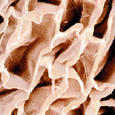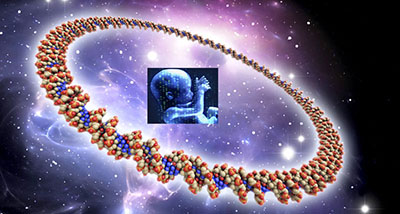Our STUDY of LIFE & the LIVING CONDITION (BIL 150)
![]()
To date there is no single agreed upon definition of life, even
though there
are some 123 published definitions of Life (E. Trifonov,
2011).
"We know it when we see it"?
Chemistry may
provide a foundation for defining Life:
All Living Things
are complex, organized molecular systems that
undergo complex chemical
reactions (metabolism and genetics), coordination,
and self-preservation,
which can unambiguously distinguish the living from
the non-living.
NASA's Exobiology Division has a statement
of life as...
Life
is a self-sustaining chemical system
capable of Darwinian evolution.
|
To answer the question... What is Life,
we will divided the course into (3) segments:
-
1st)
Cellular
& Molecular Biology (structure & function of
molecules and cells)
- 2nd) Cell Reproduction & Genetics (cell division, genomes, anf information transfer)
- 3rd) Physiology & Homeostasis (some applications to organismal physiology)
-
FIRST PART of our study will be...
- of Biology.
Cells show a remarkable
unity at the molecular and structural levels, reflecting a common ancestry.
It is variations in this unity that leads to extraordinary diversity of organisms. -
Atomic Theory is a unifying concept of Physics...
So what are the unifying Concepts of Biology*?
1. CELL
THEORY... (All living things are
composed of cells)
2. EVOLUTION...
(Organisms descend
with modifications)
3. HEREDITY...
(Gene Theory - Information
Flow)
4. BIOENERGETICS
(Energy
Transformations within Cells
and Equilibrium Thermodynamics)
|
1.
CELL
THEORY |

 |
|||
|
||||
 next page
next page |
||||
Tenets
of the Cell theory -
Universal
Features of All Cells on Earth
- all known living things (systems)
are composed of Cells
the cell is the basic unit of structure and organization in organisms and is supported
by 2 centuries of microscopic observations of many diverse organisms.
- cells arise only from
other pre-existing
cells, and not by
Spontaneous Generation:
(as established by experiments of Francisco Redi and Louis Pasteur*) - cell is the
smallest unit
of organization (of
Life) that can perform all the
physiological
activities required for life, i.e., cellular physiology. - disease is thus the
disruption of normal cellular physiology.
- all energy transformations (metabolism & biochemistry) of life occurs within cells
- all living cells on Earth store their hereditary information in DNA molecules.
Some important facts about cells
- their diversity : - many
sizes, shapes, & types* [200+
cell types in humans]NAS-6
- their similarity: - have same
basic structural plan*
- surrounded by cell membrane
- contain nuclei (bacteria
= nucleoid/genophore* = area of DNA)
- many contain similar
sub-cell parts (ORGANELLES)
What are some of
the UNIVERSAL PROPERTIES-Processes of all
cells*
![]() next page
next page
2.
EVOLUTION..."Descent
with modification"
"Nothing in biology
makes sense except in the light of evolution"
Theodor
Dobzhansky (1973) in Amer. Bio. Teacher 35:1125-129.
simply... Evolution is a change in
natural/physical characteristics of a population
over time.
Evolution
proposes that organisms living on Earth today
are the modified descendents of common
ancestors.
1858
Charles
Darwin & Alfred Russell Wallace presented papers to Linnaean
Society
with 2
important new hypotheses about
biological PATTERNS observed in the natural world.
Hypotheses:
1...
all
species (past
& present) are related by descent
from common
ancestor
2...
all
species come from preexisting
species that have changed
through time
- individuals in a population vary in hereditable traits...(look
around class)
- this accounts for the diversity
one sees in biological organisms...
- living
things change
gradually over time and
become new forms...
- from one form ------------------> to another form
-
(one
 SPECIES) -------->
(New
SPECIES) -------->
(New  SPECIES)
SPECIES)
What is the PROCESS (mechanism?) Darwin proposed for (PATTERN) of descent & change...
-
MECHANISM - is via NATURAL SELECTION ... (SURVIVAL of FITTEST)
- individuals with in a population vary in their heritable traits...
- some heritable traits help individuals survive better and/or reproduce more.
- Natural Selection picks those individuals better fit to a specific environment...
only those with superior traits (physical, behavioral, biochemical)
are more likely to SURVIVE and REPRODUCE...
-
- - Natural selection allows one
population of organisms to fragment into several
isolated in different environments... One species gradually radiates into
multiple species as geographically isolated populations adapt to different
environments over many generations over time... a whole population's
characteristics change leading to reproductive isolation (speciation).
an example of natural selection using a predation & Reproductive isolation models*
Can we observe
examples of SELECTION
acting on Populations?
Artificial
Selection...
examples
in
wild cabbage plants*...
horticultural selection of morphological traits
results in
a number of cultivars:
broccoli, cauliflower, Brussels sprouts, cabbage,
kale,
and collard
greens have all been
derived by selection from wild mustard plants.
Horticulturalists
SELECT*
wild cabbage with large buds to produce
Brussels sprouts
Natural Selection... examples:
case study 1* -
Peter & Rosemary Grant
& medium ground finch evolutionary adaptation.
UNITY...
Comes
from fact that all living things have adapted*, been
modified and
evolved by same mechanisms, the concepts
of Evolution (including molecules*)
Tree of life - Human
evolution thru time - Selection
Theory toon

The GENE THEORY is a
foundational theory of Biology which states...
Morphological traits
are passed from parents to offspring thru gene transmission.
Genes are located on
chromosomes (the Chromosomal
Theory of Inheritance) and
chromosomes are composed of deoxyribonucleic acid (DNA) complexed with
proteins.
The Laws of Heredity
transmission were described by Gregor Mendel in 1860's
and include the Law of
Segregation and Law of Independent Assortment.
The structure of DNA was deciphered by Watson & Crick in 1953
We will look at the
details of
genetics & heredity later
in the semester.

4. BIOENERGETICS - (aka... EQUILIBRIUM
THERMODYNAMICS)...
science of energy flow and transformation
within,
through, and between cells and organisms...

"cells do not produce energy...
- they consume & transform energy to stay far
away from equilibrium"
- UNITY comes from the fact that the
- mechanisms of energy change and transformation are NOT different
- among
the different life forms, but are all the SAME, and
involve
- METABOLIC PATHWAYS - chemical reactions that produce useable cell energy
- enzyme pathways* used by cells are the same in bacteria, plants & animals.
-
- glycolysis, Krebs's cycle, oxidative phosphorylation, &
photosynthesis are Universal Processes* in many cells.
|
|
|
Unity... is
chemical reactions of life being the same in
bacteria, plants, animals
|
|
 |
| the CELL is FUNCTIONAL UNIT of LIFE of all known LIVING SYSTEMS |
 |
| CELL THEORY is to BIOLOGY as ATOMIC THEORY is to PHYSICS |
 |
|
One Definition of a Cell : A
particular organization of matter, bounded by a selectively permeable membrane, that is capable of self-reproduction, without the presence of other living organism. (eliminates viruses). |
|
"Living organisms are
composed of inanimate molecules... and nothing is alive in a cell except the whole of it." Matrin Olomucki (1993) the chemistry of life. NY, McGraw Hill |
| Back Bb Next lecture |
||
|
||
SKIP ALL THE
MATERIAL BELOW:
case study
2 - feeding
preferences of different predators can cause changes
in guppy
populations
favoring long-term evolutionary changes via natural
selection
David
Reznick (UCR) & John
Endler (UCSB) - Trinidadian guppies
(1982)
experimental design and results*
and 30 years later
case study 3
-
camouflage coat color in NM dessert mice
& selection HHMI
video10 min View@home
the MOLECULAR BIOLOGY (BIOCHEMISTRY) of the CELL
- Early on Biology has looked at diversity - kinds of plants & animals known to exist.
- Today Biology uses 2
themes for study:
► an astonishing variety of Molecules,
► and an astonishing consistency of fundamental mechanisms in cells. -
Bil 150's current approach to modern biology is to stress how molecules lead to the... of Biology. Biological systems show remarkable
unity at the molecular and cellular levels, reflecting a common ancestry. It is
variations in this unity that leads to extraordinary diversity of organisms. -
Atomic Theory is the unifying concept of Physics...
So what are the unifying Concepts of Biology*?  next page
next page
" a hunt for the 1st cells: our Journey into the COSMOS of the CELL "

